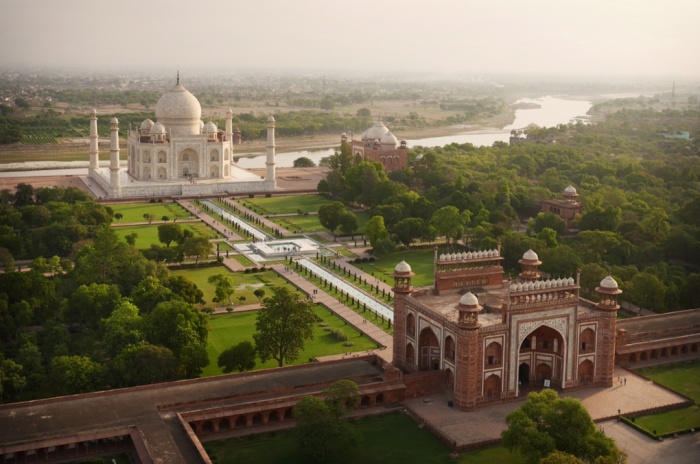
The infamous Taj Mahal is a beautiful mausoleum located on the south bank of the Yumuna River, in the city of Agra, India. It is an incredible piece of architecture built by the Mughals, former Muslim rulers of India. Taj Mahal was built in a span of 17 years, between 1631 and 1648, by orders of Emperor Shah Jahan, who ruled from 1628 to 1658, mostly in northern India. The Emperor was inspired to build this monument in dedication to his late wife, Queen Mumtaz Mahal, who died giving birth to their 14th child. Mumtaz was the emperor’s favourite of his three queens and according to the story he was devastated and filled with grief at the time of her death, prompting him to create this tomb in her memory. The “Crown Palace”, as the name of this building translates to in English, hosts the grave of the queen and emperor on the lower chamber. When the emperor died in 1666, his grave was added to next to hers. Taj Mahal was meant to represent the house of the queen in paradise; the locals believed it to be an example of what the home of all the departed looked like in paradise due to its magnificent and captivating aesthetic.
This tomb, which lies in the center of the 42-acre complex, is built entirely of white marble and contains semi-precious stones, such as jade, lapis and turquoise. It is a symmetrical structure with a large dome at the top, which has a height of 73 meters and smaller domes around it. It has four towers on each corner, also known as minarets and “iwans” on the sides, which are the arch shaped doorways. The arches and some parts on the inside of the building have very detailed flower designs carved in marble and inscriptions from the Quran. The main gate has a beautiful handwritten inscription that translated reads “O Soul, thou art at rest. Return to the Lord at peace with Him, and He at peace with you.” It is a sort of welcoming message as you enter the tomb. The design of the Taj Mahal is described as a classic example of Mughal architecture; it combines Persian, Indian and Islamic influences. This makes sense since the chief architect who designed the complex, Ustad Ahmad Lahouri, was an Indian Muslim of Persian decent. According to the legend, the emperor ordered the architect’s hands to be cut off once the work of the monument was finished so that he could never build one of its kind.

The area surrounding the main building contains a grandiose garden, fountains and pools of water. The idea of having these great gardens was important in Mughal culture because they used to be a symbol of power. The complex also has other features such as a main gateway made of red sandstone, a mosque on one side of the tomb and an identical building on the other side, directly across the mosque referred to as jawab or “mirror”, which is a guest house. These other buildings were added later once the main structure had been built.
The Taj Mahal was not very well taken care of by the Mughals post Shah Jahan’s death; their powerful empire eventually fell in the 18th century and the tomb somewhat forgotten. However, when the British were in power in India at the start of the 20th century, Viceroy Lord Curzon, ordered the monument and the area around it to be restored. It would seem odd that the British cared at all but they intended to preserve “India’s artistic and cultural heritage” for colonial purposes. The Indian government today, goes through great lengths to protect this precious complex, they have a series of procedures they follow to conserve it and protect it from getting damaged by unintentional causes or outside threats. Not too long ago, the level of pollution in the neighboring area was causing the white marble to damage, thus the government ordered factories to leave the area and eliminate or decrease other sources of pollution such as the circulation of vehicles in the proximity of the complex. In addition, the main building is protected in times of war. The government orders scaffolding to be erected in order to disguise the site and mislead airplanes so as to stop them from bombing it, this was done during WWII and their war with Pakistan.
The monument is considered one of the greatest achievements in Indo-Islamic architecture and Mughal art. Taj Mahal is one of the eight wonders of the world and recognized as UNESCO world heritage and is visited by around three million people every year. This is definitely a monument I have to see in person, I tried getting a feel for it by playing around with google maps and street views, which is the closest to it I could get but of course it is not the same as physically being there. If anyone has been to Taj Mahal in the past, please share your experience in the comments.


Hi Daniela! Unfortunately, I have not visit the Taj Mahal but my dad was able to visit when he went on a business trip to India a few years back. He said it was beautiful and it is definitely on my list of places I want to go some day!
My cousins were fortunate enough to visit the Taj Mahal a few years ago when they traveled to India. The pictures they took are breath taking, and I certainly envy them. I too would love to see the Taj Mahal in person at some point in my life, if not all eight wonders of the world.